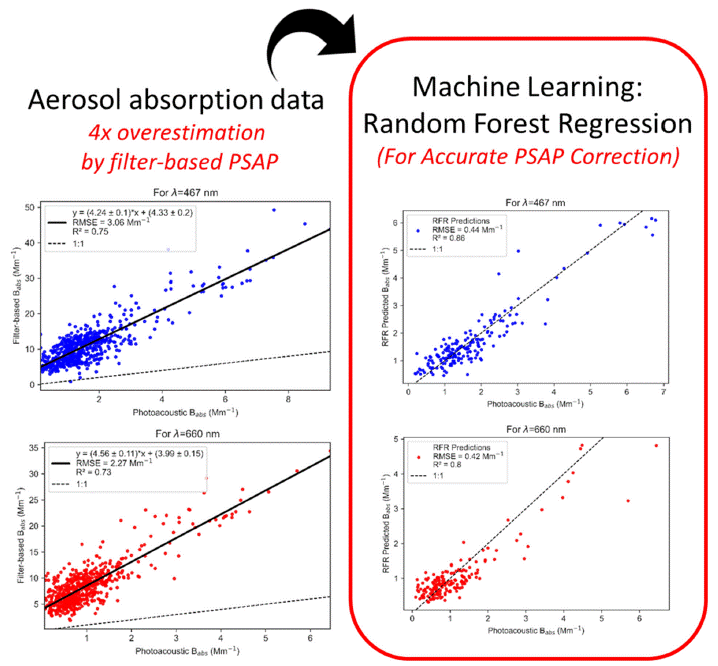Correcting for biases in aerosol light absorption data sets at ARM’s SGP observatory
Submitter
Chakrabarty, Rajan K — Washington University in St. Louis
Kumar, Joshin — Washington University in St. Louis
Area of research
Radiation Processes
Journal Reference
Science
Accurate long-term measurement of aerosol light absorption is vital for estimating direct aerosol radiative forcing. At the U.S. Department of Energy Atmospheric Radiation Measurement (ARM) user facility's Southern Great Plains (SGP) observatory, light absorption by ambient aerosols is measured using the particle soot absorption photometer (PSAP), which suffers from artifacts and biases that are difficult to quantify. Machine learning algorithms offer a promising path forward to correct for biases in the long-term absorption data set at the SGP observatory and similar Class I areas.
Impact
Low-cost, easy-to-operate, filter-based instruments, such as the PSAP, that collect aerosols on a filter and measure light attenuation through the filter, are widely used to monitor aerosol light absorption. However, filter-based absorption measurements are subject to artifacts that are difficult to quantify. These artifacts are associated with the presence of the filter medium and the complex interactions between the filter fibers and accumulated aerosols. Various correction algorithms have been introduced to correct for the filter-based absorption coefficient measurements toward predicting the particle-phase absorption coefficient. However, the inability of these algorithms to incorporate in their formulations the complex matrix of influencing parameters such as particle asymmetry parameter, particle size, and particle penetration depth results in prediction of particle-phase absorption coefficients with relatively low accuracy. In this study, we compare the performances of these algorithms and identify the best correction algorithm suitable for the SGP site.
Summary
We analyzed and compared three months of high-time-resolution ambient aerosol absorption data collected synchronously using a photoacoustic absorption spectrometer (PASS), which is a first-principles absorption measurement technique, and a PSAP. Both instruments were operated on the same sampling inlet at the SGP site. We implemented several analytical correction algorithms, as well as a Random Forest Regression (RFR) machine learning algorithm to predict particle-phase absorption coefficient (Babs) values from PSAP’s filter-based measurements. The predicted Babs was compared against the reference Babs measured by the PASS. The RFR algorithm performed the best by yielding the lowest root mean square error of prediction. It predicted Babs values within 5% of the reference Babs. Our findings suggest that machine learning algorithms offer a promising path to correct for biases in long-term filter-based absorption data sets and accurately quantify their variability and trends needed for robust radiative forcing determination.


